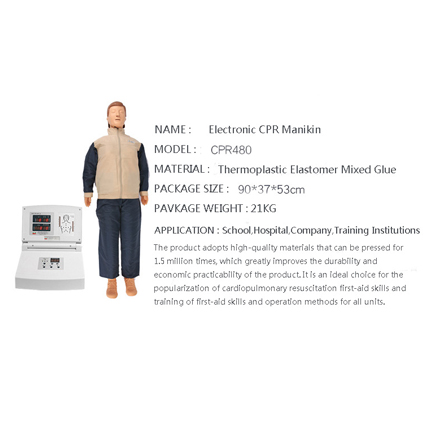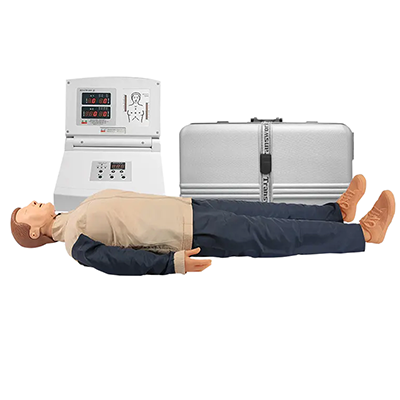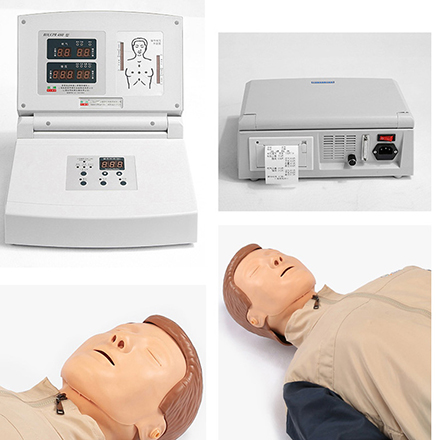In the field of first aid, cardiopulmonary resuscitation (CPR) is one of the key skills, and the quality of training directly affects the effectiveness of first aid. With the continuous evolution of first aid equipment, the limitations of traditional training methods are gradually exposed. In recent years, advanced automatic computer cardiopulmonary resuscitation simulator came into being, with its intelligent, data characteristics, quickly become the new darling of first aid training. So why does it dramatically improve first aid success? This article will combine data to explain how this device can play a key role in first aid skills training.

Advanced Fully automatic CPR resuscitation simulator
First, the core advantage of an advanced fully automated computerized CPR simulator is its precise monitoring and real-time feedback. Traditional first aid training methods mainly rely on oral guidance from instructors, which often fails to comprehensively and real-time evaluate whether the trainees' operation is standard. The simulator is equipped with advanced sensors and intelligent algorithms, which can monitor the trainees' key indicators such as pressing depth, frequency and ventilation in real time, and help students correct errors through instant feedback.
According to the data, after using the simulator, the student's press depth accuracy has increased from **60%** in traditional training to **90% **. The proportion of the press frequency that meets the standard has also increased from **70%** to **95%**. These data show that simulators effectively help students adjust their movements through real-time feedback to ensure that they can better master the standard operation of cardiopulmonary resuscitation in practice, thus laying the foundation for improving the success rate of first aid.
Each student has a different level of mastery in first aid skills, so a personalized learning program is particularly important. Traditional training courses often adopt uniform training standards, while ignoring the individual differences of students in operation. Advanced fully automated simulators can provide personalized evaluation and adjustment recommendations based on the student's operational performance. This can not only help students find their own shortcomings in time, but also effectively improve their learning results.
According to one study, participants who trained with simulators improved their skills mastery and self-correction by an average of 30%** * compared to traditional training methods. This targeted training enables students to improve their operation in a short time and reach the standard requirements faster, thereby increasing the probability of first aid success.

One of the best features of SIMS is their ability to provide comprehensive data analysis. These data are not only the immediate feedback of students in the training process, but also the concrete record of students' mastery of skills. At the end of each training session, the simulator generates a detailed report covering multiple dimensions such as press depth, frequency, and ventilation effect. This accurate assessment helps students to clearly understand their own problems in the process of first aid, so as to make targeted improvements in subsequent training.
Several studies have shown that the retention rate of students' skills after data-driven simulation training is significantly higher than that of traditional training. The data show that the trainees trained by simulators have a retention rate of first aid skills as high as **75%** * within 6 months after training, while the retention rate of traditional training methods is only about **50%**. The role of data analysis and feedback not only helps students acquire skills quickly, but also helps them maintain a high level of first aid ability over a long period of time.
Advanced fully automated simulators can simulate a variety of complex emergency scenarios, including cardiac arrest, airway obstruction and other common emergency situations. In these simulated scenarios, students are not only required to face real physiological responses, but also to make timely and accurate judgments and handling in stressful situations. This highly simulated training method can help students adapt to the real first aid scene and reduce the tension and panic during on-site rescue.

The study showed that in the human-simulated first aid scenario, the student's error rate was significantly reduced, and the student's performance in high-pressure situations was more calm. In the actual first aid process, the first-aid success rate of the trainees who used the simulator training was **30% higher than that of the trainees who did not use the simulator training. This ability to cope through realistic simulation training is one of the key factors to improve the success rate of first aid.
The traditional first aid training often relies on the guidance of the tutor, but the experience, emotion and correction method of the tutor may affect the learning effect of the student. Especially when the number of students is large, the attention and feedback of the tutor is inevitably not comprehensive enough. Simulators eliminate this problem entirely, with real-time feedback ensuring that each student is accurately guided and evaluated without human interference.
According to a survey data show that the first aid shift using simulated human training, the operation accuracy of students is **20%-30% higher than that of traditional training courses **. This type of training without outside interference allows students to focus more on the skill itself, thus improving the success rate of first aid.
Through accurate data monitoring, personalized training, real-time feedback and high simulation scenarios, advanced automatic computer cardiopulmonary resuscitation simulators help students master the key skills of cardiopulmonary resuscitation, significantly improving the success rate of first aid. From improving operational accuracy to enhancing the ability to cope with stress, from personalized training to reducing the interference of human factors, simulators have undoubtedly revolutionized first aid training. As technology continues to advance, simulators will play a more important role in the future of first aid training, helping more people master life-and-death first aid skills, thereby saving more lives.

